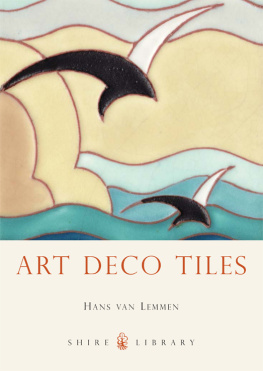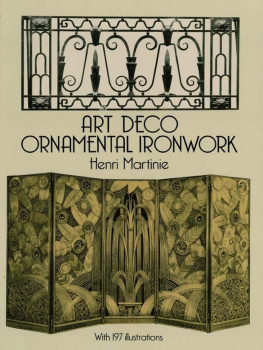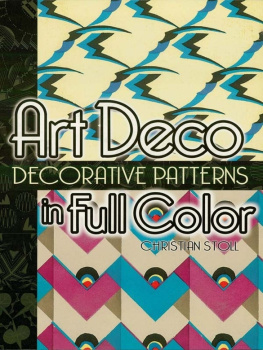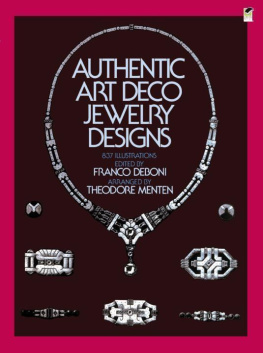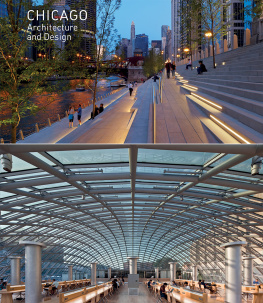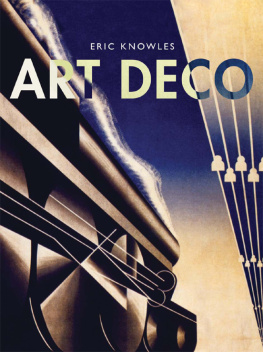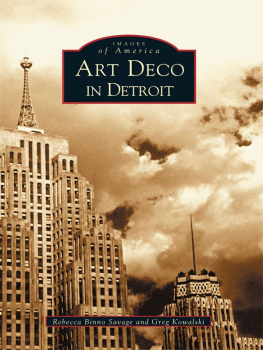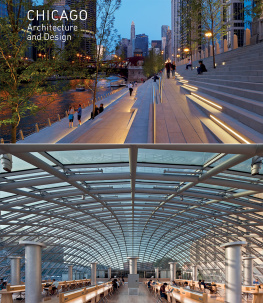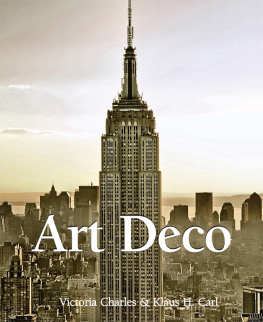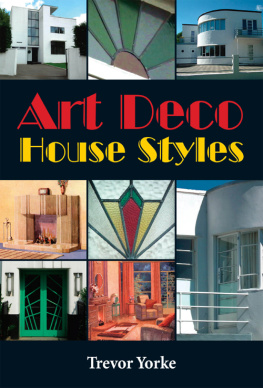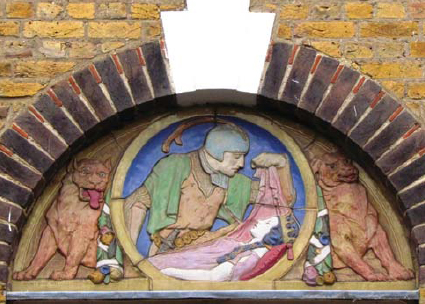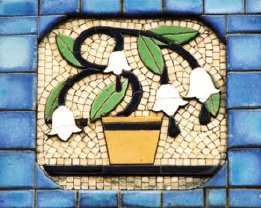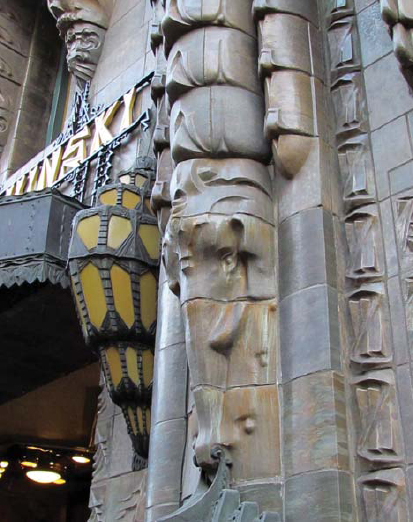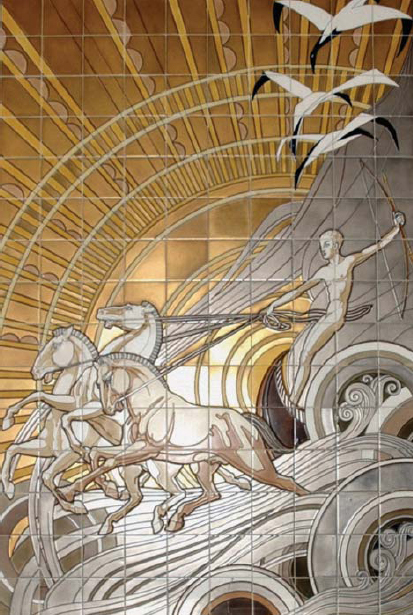ART DECO TILES
Hans van Lemmen
SHIRE PUBLICATIONS
A bold abstract Art Deco tile made by Richards Tiles, c. 1937.
CONTENTS
Lunette above one of the windows on the Sidney Street Estate in SomersTown, St Pancras, London, designed by Gilbert Bayes, 1931, showing The Soldier and the Princess.
The colourful tiled faade of the Paramount Theatre in Oakland, California, USA. Made by Gladding McBean, 1931.
INTRODUCTION
A RT DECO is recognised as the leading design movement of the 1920s and 1930s and, as such, affected many aspects of art, design and architecture, including tiles and architectural faience. It superseded Art Nouveau, which was the dominant decorative style in Europe in the late nineteenth and early twentieth centuries. Notable characteristics of Art Nouveau had been its sinuous floral designs with complex interwoven patterns of stems, leaves and flowers, and its female figures with long streaming hair, but, although things were changing, it is not always easy to draw a clear dividing line between these two design movements. The roots of Art Deco were already discernible before the onset of the First World War (191418), and Art Deco can be seen both as a reaction to Art Nouveau and as a continuation of it.
The term Art Deco comes from the important international design exhibition held in Paris in 1925 under the name Exposition Internationale des Arts Dcoratifs. It ran for six months and was seen by over fifteen million people. Such international gatherings were important venues for the dissemination and exchange of new design ideas and this exhibition in particular was intended to give an overview of the best of the modern design produced by the industrialised nations of the post-war world. With the notable exceptions of Germany and the United States, many countries were represented. Not only did France, the host country, have a national pavilion, but notable French manufacturers such as Svres and fashionable Paris design stores such as Galeries Lafayette also had their own individual pavilions. The latters pavilion was called La Maitrise, where the latest French designs of the 1920s were on show, with an emphasis on elegance, hand-applied decoration and the use of expensive materials and processes. Visitors entered the pavilion by walking under a spectacular sunburst motif that was to become the iconic design symbol of Art Deco style. The British pavilion showed the wares of British manufacturers and craftsmen such as the ceramics manufacturer Carter & Co. However, during the inter-war period the term Art Deco was not used, but the words modern or the French moderne were used instead. The term Art Deco was first used by the design critic Bevis Hillier in 1968, in his book Art Deco of the Twenties and Thirties. This was followed by a groundbreaking exhibition at the Minneapolis Institute of Arts in the United States in 1971 called The World of Art Deco. Since then Art Deco has become recognised as one of the most exciting and important episodes in the history of twentieth-century design, noted for its sleek aerodynamic lines, highly stylised figurative designs and bold colourful abstract patterns.
Art Deco was an eclectic style that drew on many different stylistic influences, such as European avant-garde (particularly the abstract art of painters such as Kandinsky, Malevich and Mondrian), classical architecture, the ancient civilisations of Egypt and South America and exotic cultures from the Far East. These myriad sources can also be seen in the design of tiles and architectural faience, but how this manifested itself varied greatly from country to country. Art Deco was a much more vehement design force on the continent of Europe and in the United States than in Britain, and, before examining what happened in Britain in more detail, it may be useful to look briefly at what was produced elsewhere by designers and manufacturers in the 1920s and 1930s.
In France, Art Deco tiles and faience were often characterised by stylised and elegant designs with much emphasis on hand-crafted forms and techniques. The firm Fourmaintraux in Desvres produced some interesting work of this kind. In the Netherlands there was a strong predilection for expressionist and exotic designs, of which the famous Tuschinski Theatre in Amsterdam is a case in point. The faience decorations on the exterior of this building range from human and animal forms cowering under jagged thunderbolts, to ornamental features borrowed from Hindu temples in Indonesia, including elephants heads. In Belgium the designer Joseph Roelants created some dazzling Art Deco tile panels for the firm Gilliot & Cie at Hemiksem, depicting subjects such as the Greek sun god Apollo descending from the heavens in a chariot, executed in gold and silver tiles. Even in Spain the Art Deco style manifested itself often with typical southern exuberance. Tiled dados for the entrances of Spanish houses featured bright abstract designs and colours, augmented with cartoon characters suvh as Mickey Mouse, showing how the design of tiles could be influenced even by American film culture. During the 1920s and 1930s Art Deco was a very strong influence in the United States, where skyscrapers, office blocks, apartment blocks, theatres and cinemas were often decorated with a vast array of figurative or abstract tiles and architectural faience on a scale unseen in Europe. The Paramount Theatre in Oakland, California, with monumental Art Deco tiling made by the firm Gladding McBean, is a prime example of this trend.
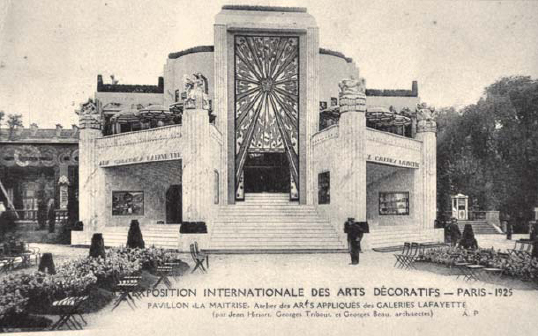
Postcard of the pavilion of the Galeries Lafayette at the Exposition Internationale des Arts Dcoratifs et Industriels Modernes in Paris, 1925. It was one of the leading pavilions in the show, with a striking sunburst motif over the entrance.
Tile-and-mosaic panel showing a stylised plant in a flowerpot in the Art Deco style on a shop front in Desvres, Pas-de-Calais, made by Fourmaintraux & Delassus in Desvres, c. 1925.
Detail of the Art Deco faience decorations on the faade of the famous Tuschinski Theatre in Amsterdam made by Plateelbakkerij Delft, Hilversum, Netherlands, in 1921. The exotic forms of the faience, glass and metal decorations are reminiscent of German Expressionism.
An exuberant Art Deco tile panel showing the sun god Apollo in his chariot, riding the heavens. Designed by the artist Joseph Roelants and made by Gilliot & Cie, Hemiksem, Belgium, 1935.

